Best headless guitars 2025: 8 top picks for all budgets and player styles
Intrigued at the prospect of losing your head? Here’s our pick of headless guitars from Ibanez, Strandberg, Traveler, Steinberger, Legator and more
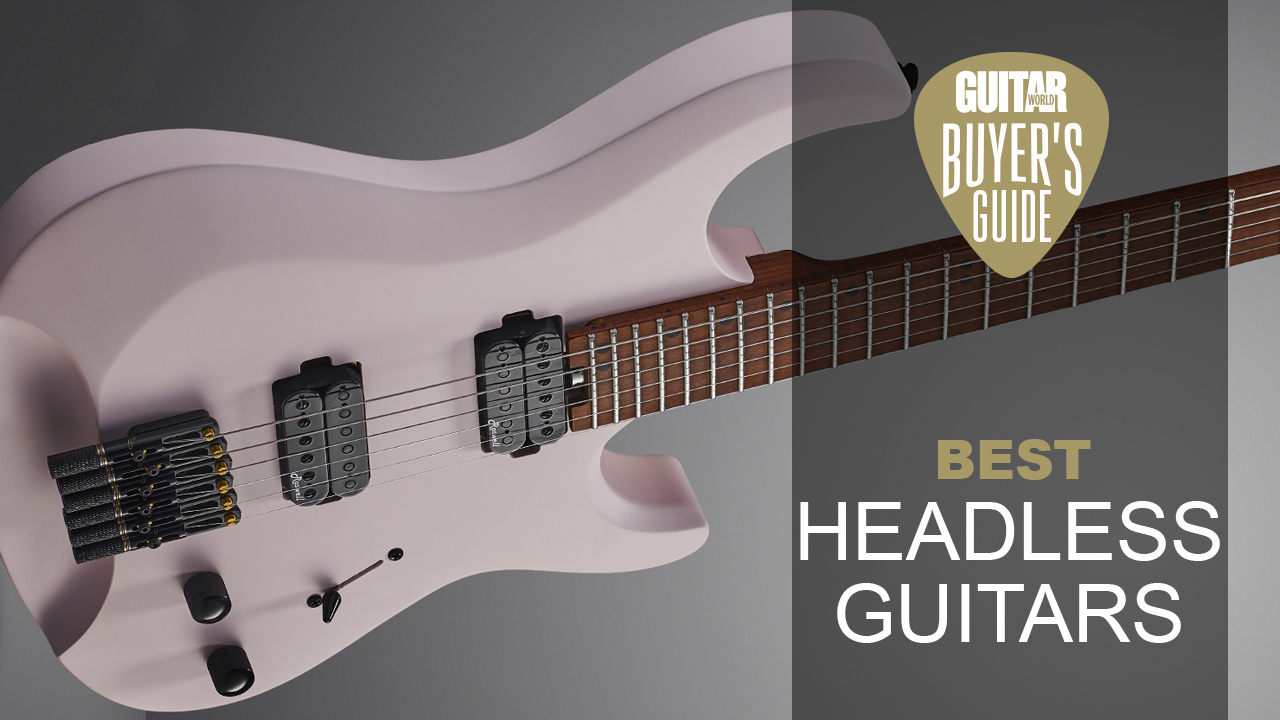
If you’ve always dreamed of wielding one of the best headless guitars, then we urge you to read on – we’ve got some real treats in store for you. If, however, you’re a tad wary of the admittedly unconventional-looking headless axe species then we strongly urge you to read on. Trust us, in no time at all you’ll wonder why all guitars aren’t made this way.
Why buy a headless guitar? Because you’d be mad not to. They’re better balanced, more compact, lighter to wear, they stay in tune for longer and they’re easier to string. Oh, and they look cool – well, we think so anyway.
So, whether you love them or loathe them, read on to discover our choice of the best headless guitars available today.
Best headless guitars: Guitar World recommends
Headless guitars are for those of us who are ready to push tradition aside and embrace a more modern future. Whatever genre of music you play there’s one here for you, but it’s true that contemporary metal players do seem best served by what’s currently on offer.
To that end, the Strandberg Boden Metal NX 7 is an awesome instrument with killer looks and murderous tone. But, knock back the gain, or dig in a little less, and you’ll discover a guitar that’s as dynamic and articulate as any.
Still, if the Strandberg is a bit much in both visual presence and price then check out the Ibanez Q54. Here’s a guitar that’s versatile, balanced, inexpensive and won’t humiliate you in polite company. Ibanez has developed it to appeal to the contemporary guitarist who enjoys playing a broad repertoire of music – who knows, it may just become your favorite guitar.
Best headless guitars: Product guide
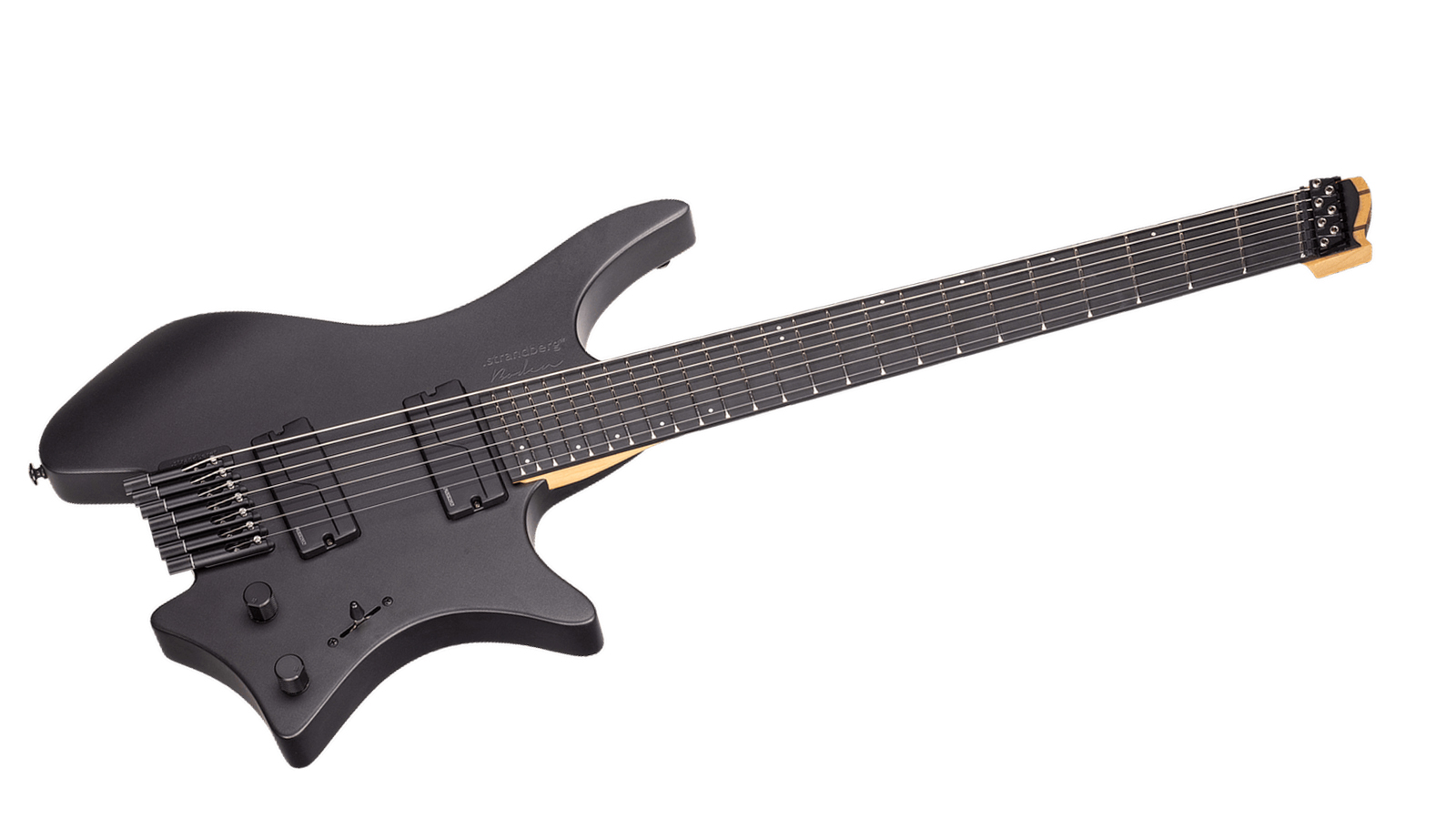
1. Strandberg Boden Metal NX 7
Our expert review:
Specifications
Reasons to buy
Reasons to avoid
Sleek, powerful, aggressive and utterly mad, if this isn’t a perfect guitar for contemporary metal then we don’t know what is. The Boden Metal boasts seven strings for low-end djent, active Fishman Fluence Modern pickups for out-and-out power, a chambered basswood body for tone and handling, together with a carbon-reinforced maple neck that’s topped with a fast Richlite fingerboard and fanned frets. It’s a monster.
Not enough? Well, there’s an 8-string version available too for all you low, low E string thumpers and it’s available in a variety of alternative crazy-colorways.
Somewhat surprisingly, hiding beneath that snarling façade you’ll discover an articulate instrument that can be beautifully expressive when you want it to be. A sensitive tone shaped in no small part by its fantastic alnico Fishman neck pup. Turns out the Boden Metal can be a bit of a pussy cat.
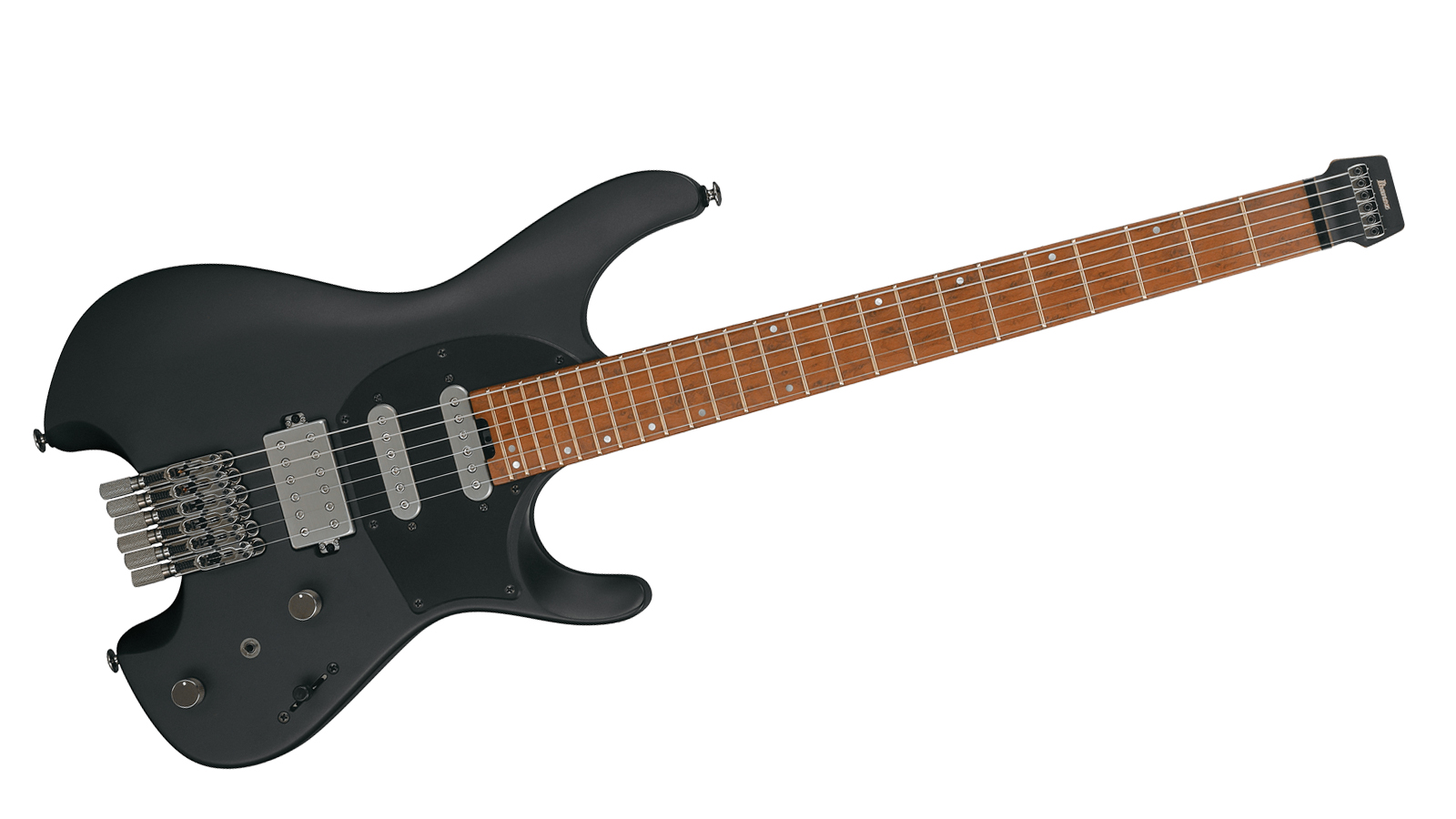
2. Ibanez Q54
Our expert review:
Specifications
Reasons to buy
Reasons to avoid
Here’s proof that not all headless guitars are built to satisfy the ‘pointy’ end of the market. The boundary busting Q54, with its flowing S-type curves and soft belly-cuts, is aimed at the contemporary, technical player who values a wide range of tonal possibilities.
The HSS configuration – a ceramic Q58 humbucker in the bridge plus two R1 single coils – combined with Ibanez’s dyna-MIX9is switching system – is about as versatile as it gets. It’s even possible to combine the two single coils so that they approximate a ‘bucker.
A benefit of headless guitar development is the ability to spec a separate bridge for each string. The Q54’s Mono-Tone doesn’t disappoint in this respect. Its individual bridges offer a wide intonation range that makes tuning down a step or more blissfully easy.
Available in Flat Black or Fender-like Sea Foam Green, this is a guitar that’ll leave you smiling whatever genre you attempt to play on it.
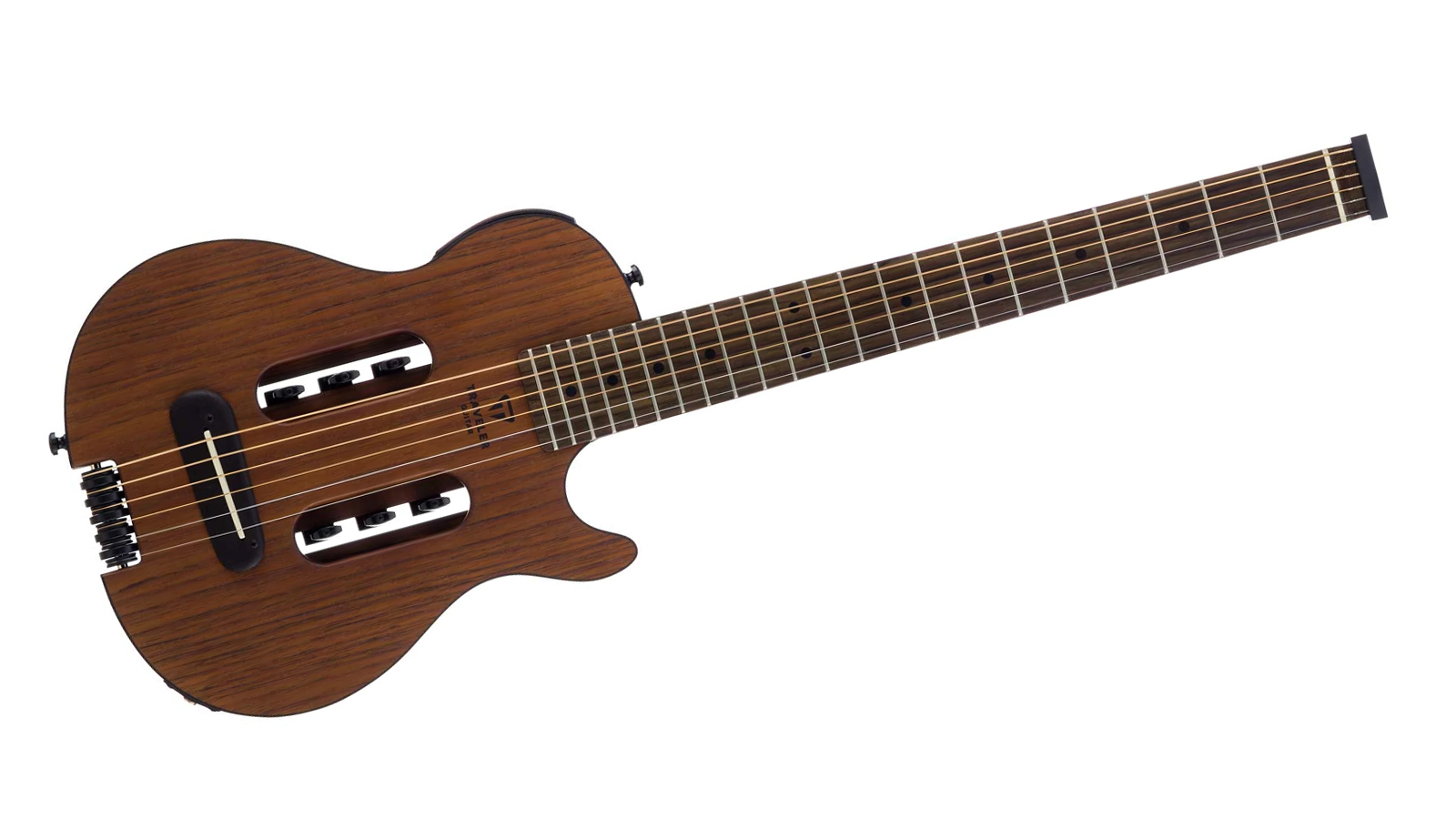
3. Traveler Guitar Escape Mark III
Our expert review:
Specifications
Reasons to buy
Reasons to avoid
Admittedly, at first glance it’s hard to know what to make of the Escape travel guitar. First, it’s darned small. Its tiny, almost uke-like frame is the fraction of the size of a full-blown acoustic or electric guitar, yet it retains a full 25.5” scale length. Second, it’s an acoustic-electric that sounds predominately acoustic, but needs to be plugged in to get any sort of tone out of it. Third, well, those tuners…
Get over its quirky looks though and it’s great fun to both play and listen to. In the unlikely event that you’ve hauled your acoustic amp with you on the bus or the plane, you can plug straight in and start jamming wherever you are in the world.
Didn’t bring an amp? No matter. The Escape features a headphone amp, which means that all you really need to pack for your travels are some earbuds, a toothbrush and some clean undies. It even boasts a guitar tuner and an aux in so that you can strum along to your favorite backing tracks.
It’s no D28, but it’s certainly good enough to keep you entertained out on the road, on the beach or in the back country.
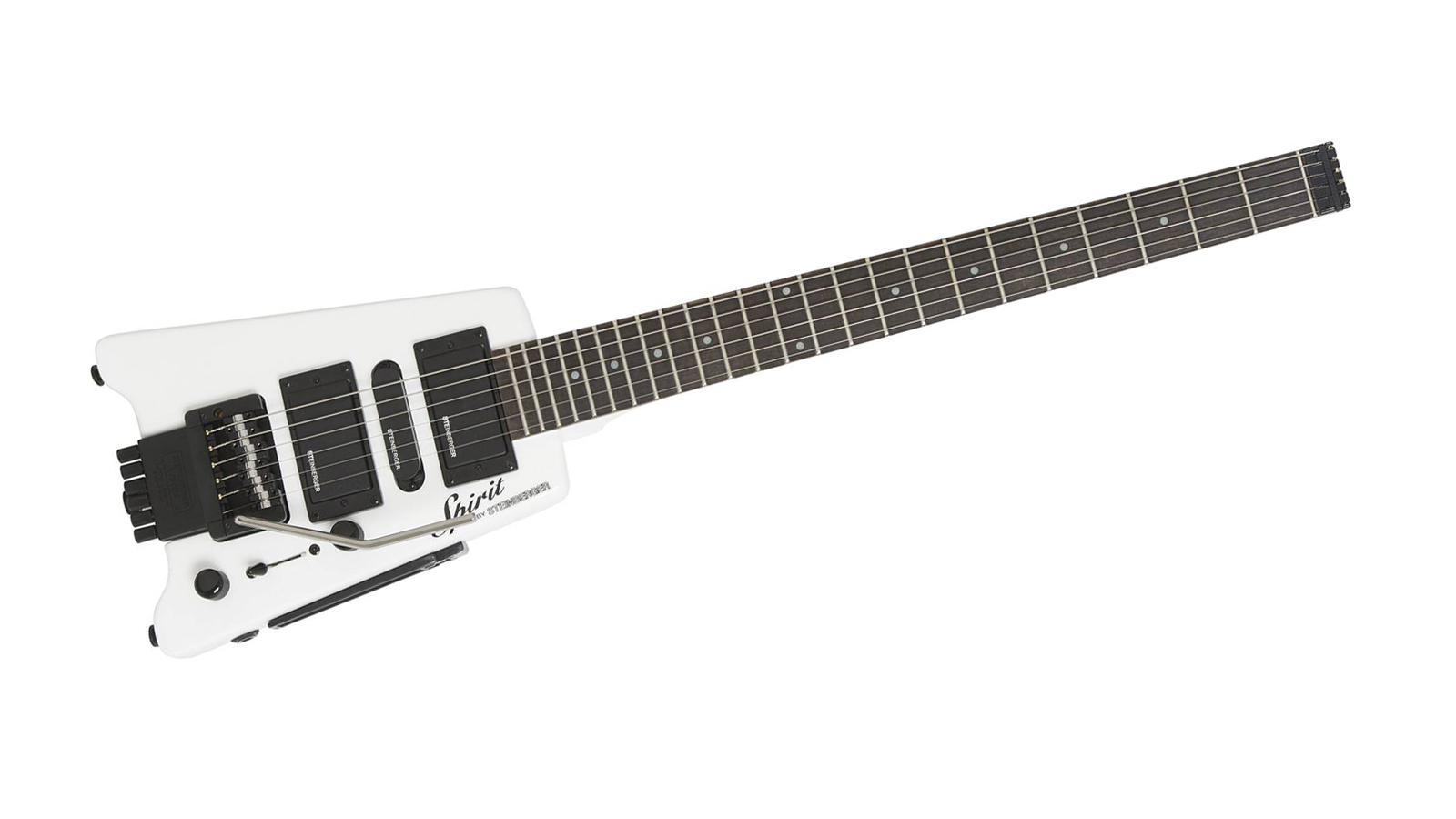
4. Steinberger Guitars GT-Pro Deluxe
Our expert review:
Specifications
Reasons to buy
Reasons to avoid
Ned Steinberger invented the headless guitar back in the late ’70s, a pioneering design that proved quite the phenomenon throughout the ’80s but then slowly drifted out of fashion. By then, Ned had already sold the brand to Gibson, which ceased production of the original product line in the 1990s.
Now, they’re back with the Spirit line, which is an homage to Ned’s original ground-breaking series of headless basses and guitars.
The first thing you’ll notice about the GT-Pro Deluxe is that there’s very little to it – even Steinberger is touting this as the ultimate travel guitar. The ‘almost not there’ basswood body is attached to a three-piece hard maple neck that’s pretty much impervious to climatic changes. This, the locking trem, and double ball-end strings make the GT-Pro an extremely reliable and stable instrument to travel and gig with. In Steinberger’s words it’s ‘virtually indestructible’.
In some ways, this Steinberger demonstrates that you don’t get much for a few hundred dollars these days. On the other hand, the GT-Pro Deluxe offers you a whole lot more than many traditional guitars ever will.
It’s available in a variety of funky colors, from plain black to hotrod yellow.
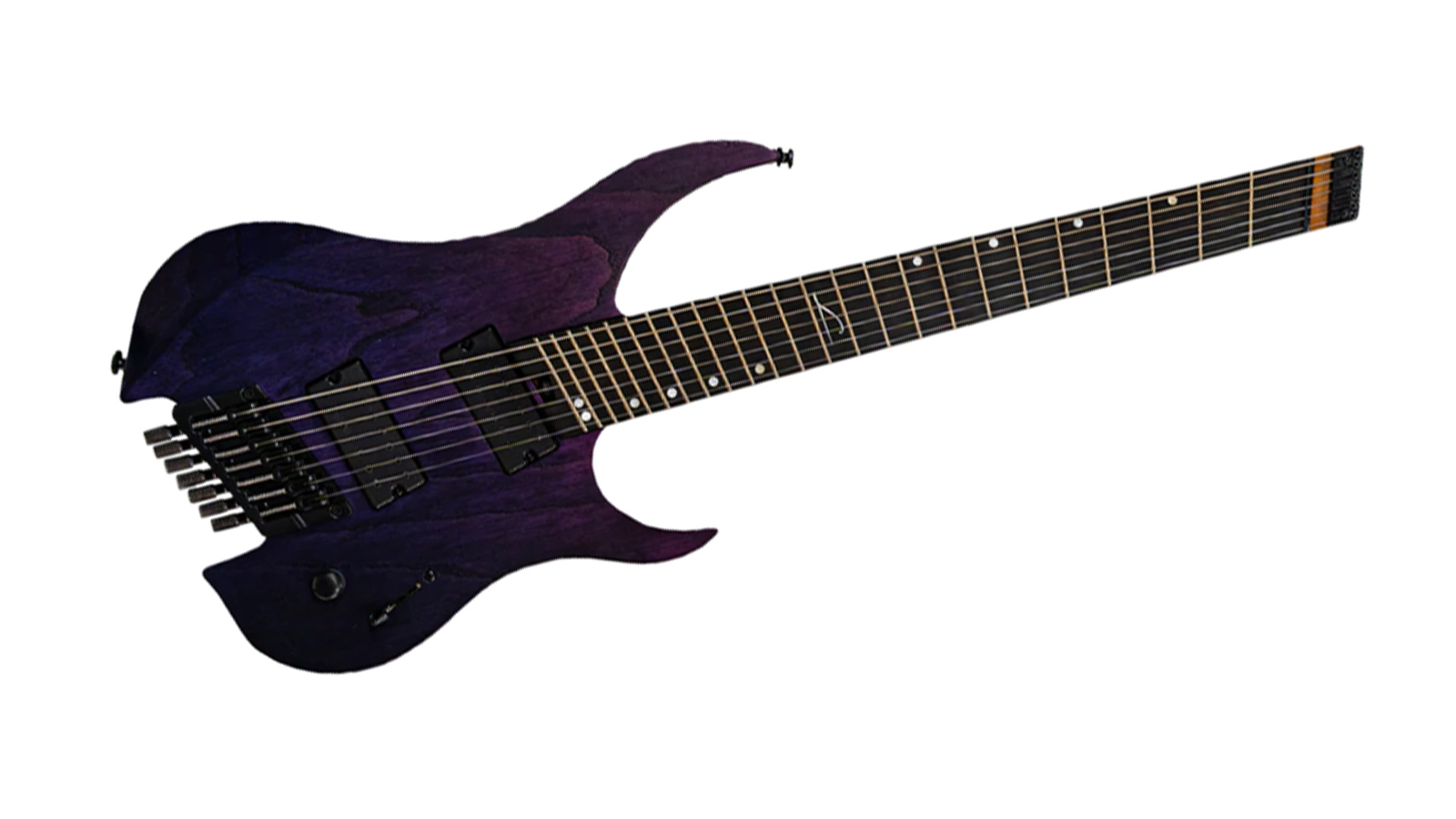
5. Legator Ghost G7FP
Our expert review:
Specifications
Reasons to buy
Reasons to avoid
Legator is a relatively small outfit based in Los Angeles, so if you’re hunting for a guitar that’s out of the ordinary but doesn’t cost a fortune they’re well worth a look.
Now’s a good time too, because it’s updated its headless Ghost range for 2022 with some tasty upgrades. All Ghosts now get a roasted maple neck, ebony fingerboard and Hive 2.0 humbuckers. The pups are especially interesting because they’ve been developed to remain clear and articulate across a broad spectrum of frequencies. In practice, this means Legator’s seven and eight string guitars sparkle and chime at the top end while remaining mud-free at the bottom.
It makes perfect sense to go headless with guitars that have more than six strings. These require additional tuning machines, which calls for bigger headstocks and more weight, which does little for balance. Bringing that mass down to the guitar’s body, as Legator has done with the G7FP, lowers the center of gravity, enhancing stability.
Six and eight string versions are also available.
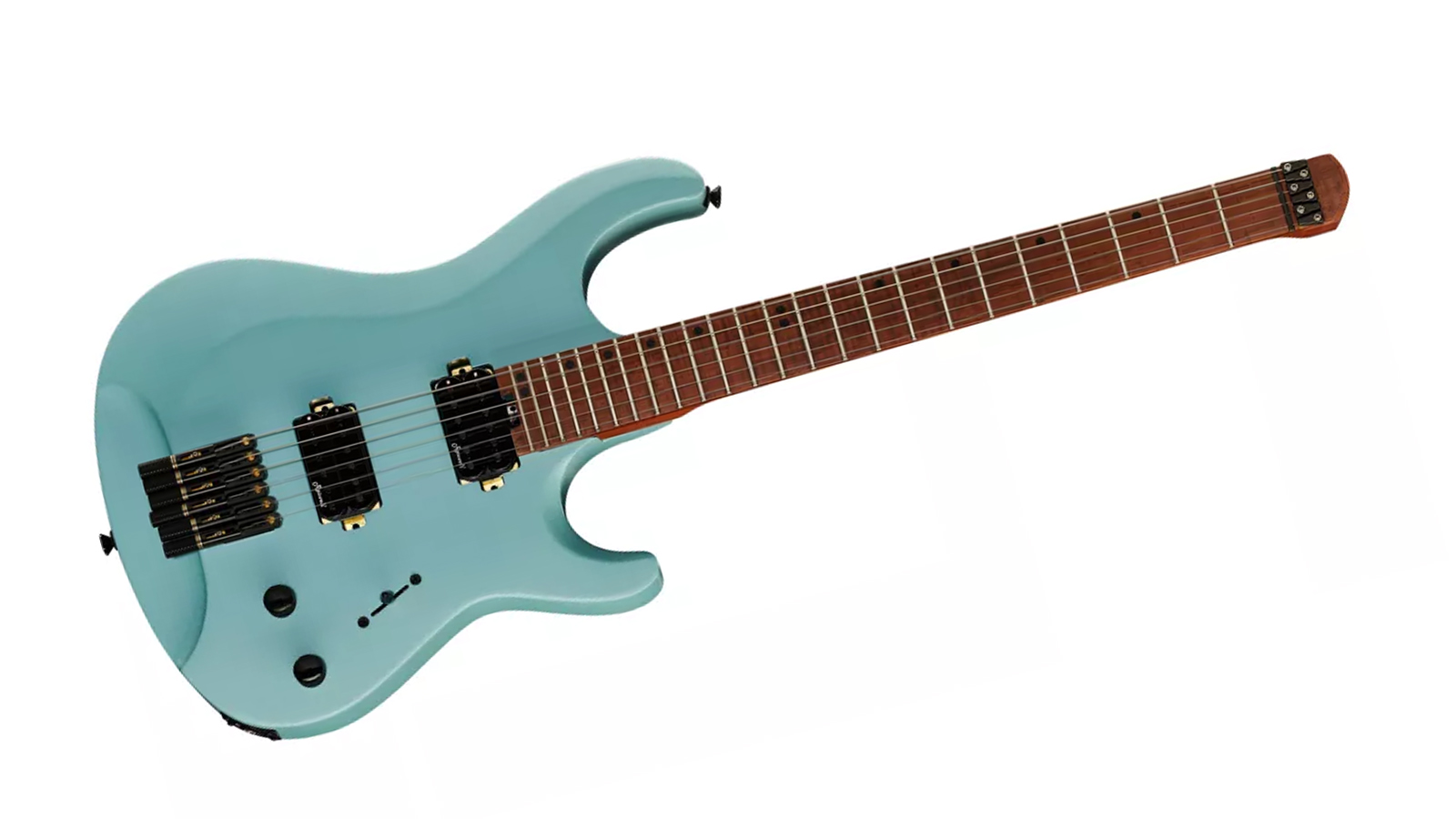
6. Harley Benton Dullahan-FT 24 Roasted
Our expert review:
Specifications
Reasons to buy
Reasons to avoid
If you don’t have a load of cash, but still want a guitar that looks a bit flash, Harley Benton has got you covered. It’s not uncommon to find entry-level guitars with this kind of ticket price, but it’s very unusual to find one with this high-end level of spec.
For your modest outlay you get all the usual benefits of owning a headless guitar plus an ergonomically shaped S-type alder body, roasted flamed maple neck, roasted maple fingerboard, stainless steel frets, a Graph Tech Tusq nut, five-way switchable electronics, two Roswell humbucker pickups and a gig bag. That’s a proper spec, rarely found on guitars twice this price.
Thomann also throws in a three-year warranty. What’s not to like?

7. Strandberg Sälen Jazz NX NA
Our expert review:
Specifications
Reasons to buy
Reasons to avoid
Take an idle glance at Strandberg’s catalog and it’s easy to come away with the misconception that the company’s remit is to develop the most ferocious guitars available on the planet. Which just isn’t true. Sure, models such as the Boden Metal NX, featured elsewhere in this guide, are bonkers – but there’s a whole lot more to Strandberg. Like the Sälen Jazz NX.
Ultimately, Strandberg is concerned with ergonomics, tone and sustainability. Unlike some other brands we could mention, that are shackled by their heritage, it’s free to keep innovating, to keep pushing the envelope. The Sälen Jazz NX is unlike any other jazz box we’ve ever seen but it sounds incredible and is a joy to play.
Is it heresy to suggest that jazz guitars should move with the times? Why? The Sälen Jazz NX, with its chambered body and warm, rich tone can cover any ground from the cleanest jazz to the filthiest blues and rock. In great comfort and with peerless reliability.
If you’re going to buy just one guitar, this could well be it.

8. Ibanez QX527PB-ABS
Our expert review:
Specifications
Reasons to buy
Reasons to avoid
Ibanez has really got behind the recent resurgence in headless guitars, to the point of developing a brand-new line of ‘Q’ (for Quest) models that feature the most contemporary tech and components.
The QX527PB-ABS (who makes up these names?) is an HH configured headless S-type guitar that’s similar in concept to the previously mentioned Q54 but with some eye-catching differences.
It’s impossible to miss the stunning Poplar Burl top but look closely and you’ll also see that the frets have been slanted by 8 degrees. Ibanez has noticed that contemporary players favor playing high up the fretboard, which often results in the four fretting fingers tilting slightly inwards. The 8-degree slant compensates for this, making for a more comfortable fretting experience.
The two Q58 pups have been developed specifically for seven-plus string headless guitars, with improved tonal definition across the spectrum. They can be tapped countless ways with the five-way switch and Ibanez’s dyna-MIX10 system.
If you crave a seven string with the most contemporary appointments, then this one's well worth considering.
Best headless guitars: Buying advice

The Fender Telecaster. In our opinion it’s one of the finest looking, best performing electric guitars ever. Yes, the Strat is more refined, a Gretsch – any Gretsch – is more characterful and a 355 has way more class but Leo’s humble Tele is the original and the best.
Except, perhaps it’s not. You see, Leo Fender got it all wrong when he set out to invent the world’s first mass produced electric guitar. He made the mistake of modeling its silhouette on an acoustic guitar which, in turn, was based on a medieval lute-like instrument called a gittern.
The thing is, these acoustic instruments and those before them rely on having a thin resonant top and voluminous soundbox to make and project sound. Stick a bunch of tuning gubbins down by the bridge and it’ll snuff the life out of that resonant top. It’ll dampen it more than a wet weekend camping trip.
But a solid body guitar doesn’t have a resonant top, which means the tuners don’t have to live up on the headstock. Which also means, you’ve guessed it, there’s no need for a headstock at all. How could Leo have missed something so obvious? What a buffoon.
We are, of course, being facetious. Leo Fender is rightly regarded as a design and engineering genius. Nobody else at the time cottoned on to this oversight either – Burns, Epiphone, Gretsch, Hofner, Vox, Rickenbacker et al all continued to build solid body basses and guitars throughout the ‘50s, ‘60s and beyond with headstocks sprouting tuners.
In fact, it took until the late ‘70s before an engineer named Ned Steinberger (a non-musician like Leo) realized that there was another way. He didn’t just turn instrument design on its head, he decapitated it. Here’s why...
Balance
You can trust Guitar World
Ned first experimented with bass guitars, because they have long necks and large headstocks. That’s a lot of weight, enough to throw them off balance. Removing the headstock makes it easier to engineer a bass, or guitar, with neutral handling – no more neck dives.
Lightness
Solid body guitars are heavy, if you gig with a Les Paul you’ll know exactly what we mean. Headless guitars naturally weigh a bit less but it’s almost de rigueur for manufacturers to equip them with minimalist, barely-there bodies too. If you suffer from back or shoulder pain then they’re a good choice.

They're easy to string
Stringing a guitar is hardly difficult but it is a faff. Not so with a headless guitar. The ball end is threaded through the bridge and the needlessly sharp end (ouch!) is locked down at the nut before being trimmed. It’s a 45 second job.
Some models string the other way around with the ball end at the nut, but they’re few and far between. Steinberger guitars feature special strings with a ball end at both the nut and bridge.
They stay in tune
The locking nut and secure, gearless, straight-through tuners reduce slippage and promote faster, more stable tuning. Many headless guitars also feature ultra-low ratio 40:1 tuners that are far more accurate than standard tuning machines.
Open strings can sound better (or worse)
Some headless guitars feature a zero fret, which means the nut is relegated to string guidance duties while a neighboring fret quite literally takes up the slack. This means your open notes will sound very similar in tone to fretted notes. Some people love this, but others prefer their open strings to ring out with unbridled liveliness.
Zero frets are also claimed to improve intonation and tuning stability.
They’re your traveling companion
Despite most having a standard scale length, headless guitars pack up small, which makes them ideal instruments to travel with. Some even have bodies fashioned from a spartan collapsible framework that can be dismantled in a jiffy.
They look cool
When is guitar design going to move on from the ‘50s and ‘60s? OK, we accept that headless guitars do look a bit ‘80s, but at least they don’t look like something your great-grandad used to play.
Rightly or wrongly, they tend to be associated with metal but plenty of artists from other genres have used them to good effect too. Sting, Mark Knopfler, Allan Holdsworth and Yvette Young have all been known to go headless…
And, because headless guitars are not constrained by tradition they’re more likely to be fitted with ‘out-there’ features such as fanned frets.
Evolution or revolution? It’s a matter of perception and personal preference but all in all, they’re a worthy descendant of the original solid body guitar.
How we choose products
At Guitar World, our expert team is made up of actual musicians who have spent many years playing and testing all things guitar. Our passion and extensive knowledge allow us to draw on real-world experience of using these products in live performances, recording sessions, and rehearsals. This allows us to make an informed selection when choosing the best guitars and guitar gear for our guides.
When determining the top headless guitars available in the market, we rely on our hands-on experience, user reviews, and extensive discussions with our editorial colleagues to reach a consensus. As guitar players ourselves, we understand the importance of finding the right guitar, and we take into careful consideration factors such as price, features, ease of use, and durability to create a list of the best headless guitars on the market.
Our goal is to help fellow guitar players find the perfect guitar that meets their specific needs and preferences. Therefore, we are dedicated to providing reliable and trustworthy recommendations that reflect our expertise and love for everything guitar-related.
Read more about our rating system and exactly how we test each product.
Related buyer's guides
- The best amp modelers you can buy right now
- The best 7-string guitars for every budget
- Best 8-string guitars: djent-friendly electrics
- These are the best metal guitars on the planet
- Play it loud with the best punk guitars
Get The Pick Newsletter
All the latest guitar news, interviews, lessons, reviews, deals and more, direct to your inbox!
When Simon's childhood classical guitar teacher boasted he 'enjoyed a challenge', the poor man had no idea how much he'd underestimated the scale of the task ahead. Despite Simon's lack of talent, the experience did spark a lifelong passion for music. His classical guitar was discarded for an electric, then a room full of electrics before Simon discovered the joys of keys. Against all odds, Simon somehow managed to blag a career as a fashion journalist, but he's now more suitably employed writing for Guitar World and MusicRadar. When not writing or playing, he can be found terrifying himself on his mountain bike.
“It holds its own purely as a playable guitar. It’s really cool for the traveling musician – you can bring it on a flight and it fits beneath the seat”: Why Steve Stevens put his name to a foldable guitar
“Finely tuned instruments with effortless playability and one of the best vibratos there is”: PRS Standard 24 Satin and S2 Standard 24 Satin review











